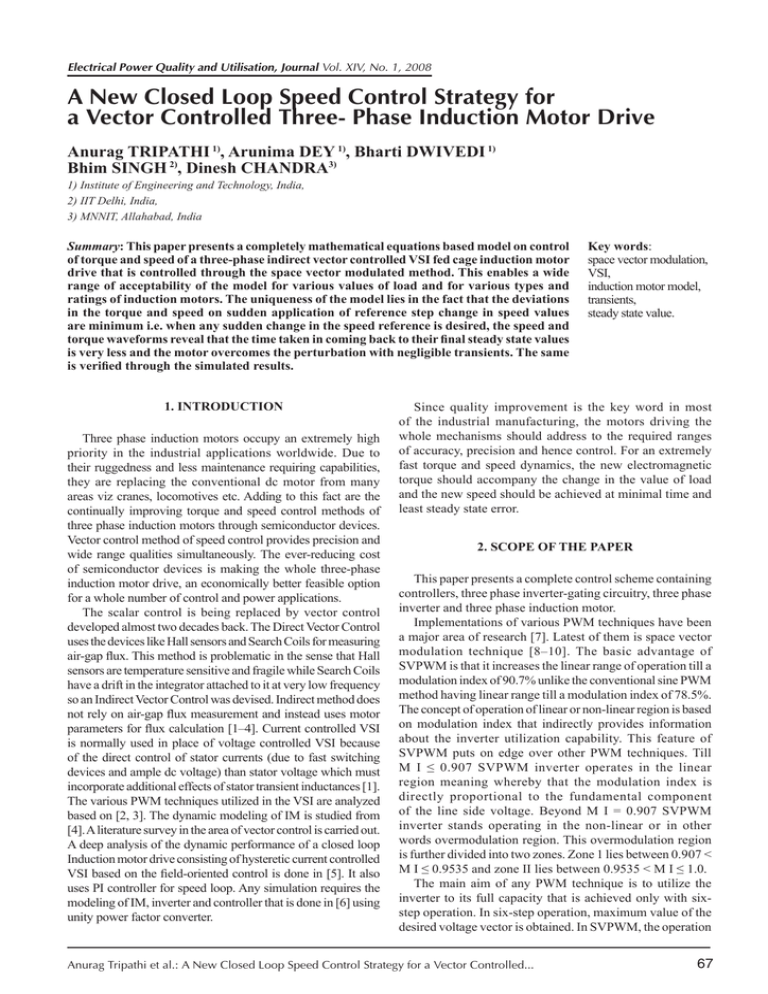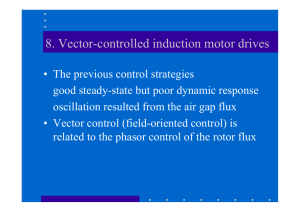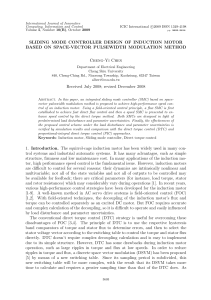A New Closed Loop Speed Control Strategy for a Vector Controlled
advertisement

Electrical Power Quality and Utilisation, Journal Vol. XIV, No. 1, 2008
A New Closed Loop Speed Control Strategy for
a Vector Controlled Three- Phase Induction Motor Drive
Anurag Tripathi 1), Arunima Dey 1), Bharti Dwivedi 1)
Bhim Singh 2), Dinesh Chandra3)
1) Institute of Engineering and Technology, India,
2) IIT Delhi, India,
3) MNNIT, Allahabad, India
Summary: This paper presents a completely mathematical equations based model on control
of torque and speed of a three-phase indirect vector controlled VSI fed cage induction motor
drive that is controlled through the space vector modulated method. This enables a wide
range of acceptability of the model for various values of load and for various types and
ratings of induction motors. The uniqueness of the model lies in the fact that the deviations
in the torque and speed on sudden application of reference step change in speed values
are minimum i.e. when any sudden change in the speed reference is desired, the speed and
torque waveforms reveal that the time taken in coming back to their final steady state values
is very less and the motor overcomes the perturbation with negligible transients. The same
is verified through the simulated results.
1. Introduction
Three phase induction motors occupy an extremely high
priority in the industrial applications worldwide. Due to
their ruggedness and less maintenance requiring capabilities,
they are replacing the conventional dc motor from many
areas viz cranes, locomotives etc. Adding to this fact are the
continually improving torque and speed control methods of
three phase induction motors through semiconductor devices.
Vector control method of speed control provides precision and
wide range qualities simultaneously. The ever-reducing cost
of semiconductor devices is making the whole three-phase
induction motor drive, an economically better feasible option
for a whole number of control and power applications.
The scalar control is being replaced by vector control
developed almost two decades back. The Direct Vector Control
uses the devices like Hall sensors and Search Coils for measuring
air-gap flux. This method is problematic in the sense that Hall
sensors are temperature sensitive and fragile while Search Coils
have a drift in the integrator attached to it at very low frequency
so an Indirect Vector Control was devised. Indirect method does
not rely on air-gap flux measurement and instead uses motor
parameters for flux calculation [1–4]. Current controlled VSI
is normally used in place of voltage controlled VSI because
of the direct control of stator currents (due to fast switching
devices and ample dc voltage) than stator voltage which must
incorporate additional effects of stator transient inductances [1].
The various PWM techniques utilized in the VSI are analyzed
based on [2, 3]. The dynamic modeling of IM is studied from
[4]. A literature survey in the area of vector control is carried out.
A deep analysis of the dynamic performance of a closed loop
Induction motor drive consisting of hysteretic current controlled
VSI based on the field-oriented control is done in [5]. It also
uses PI controller for speed loop. Any simulation requires the
modeling of IM, inverter and controller that is done in [6] using
unity power factor converter.
Key words:
space vector modulation,
VSI,
induction motor model,
transients,
steady state value.
Since quality improvement is the key word in most
of the industrial manufacturing, the motors driving the
whole mechanisms should address to the required ranges
of accuracy, precision and hence control. For an extremely
fast torque and speed dynamics, the new electromagnetic
torque should accompany the change in the value of load
and the new speed should be achieved at minimal time and
least steady state error.
2. Scope of the Paper
This paper presents a complete control scheme containing
controllers, three phase inverter-gating circuitry, three phase
inverter and three phase induction motor.
Implementations of various PWM techniques have been
a major area of research [7]. Latest of them is space vector
modulation technique [8–10]. The basic advantage of
SVPWM is that it increases the linear range of operation till a
modulation index of 90.7% unlike the conventional sine PWM
method having linear range till a modulation index of 78.5%.
The concept of operation of linear or non-linear region is based
on modulation index that indirectly provides information
about the inverter utilization capability. This feature of
SVPWM puts on edge over other PWM techniques. Till
M I ≤ 0.907 SVPWM inverter operates in the linear
region meaning whereby that the modulation index is
directly proportional to the fundamental component
of the line side voltage. Beyond M I = 0.907 SVPWM
inverter stands operating in the non-linear or in other
words overmodulation region. This overmodulation region
is further divided into two zones. Zone 1 lies between 0.907 <
M I ≤ 0.9535 and zone II lies between 0.9535 < M I ≤ 1.0.
The main aim of any PWM technique is to utilize the
inverter to its full capacity that is achieved only with sixstep operation. In six-step operation, maximum value of the
desired voltage vector is obtained. In SVPWM, the operation
Anurag Tripathi et al.: A New Closed Loop Speed Control Strategy for a Vector Controlled...
67
from under modulation to overmodulation finally leads to
the above-mentioned fact i.e. to achieve a six-step operation.
In the overmodulation range, the fundamental component
of the line side voltage and the modulation index are no
more proportional. The present paper establishes a linear
relationship between them.
The present paper thus also covers the overmodulation
region of the space vector modulation (i.e. from 90.7% to
100% till six step).
In the paper, a combination of step waveforms is given as
a reference speed that is compared with the actual speed. The
resulting speed error is given to a PI controller whose output
is then subjected to a matlab function that has one more input
that is the actual speed. This Matlab function takes care of
the field-weakening region. The logic equations applied in
it are as follows:
Where
me_ref = Reference Torque; me_ max = Maximum Torque;
w = rotor speed.
Function torq _ ref = torq_ ref (me_ref, w)
If (w < 1.0
or w = = 1.0)
me_max = 1.0;
end
If (w > 1.0)
me_max = 1.0/w;
end
The above two logics decide the constant torque region
(till the base speed) and field (and hence torque) weakening
region beyond base speed,
If (me_ref > me _ max)
end
Torq _ref = [me_ref]
The above logic fixes the value of me_ref at equal to or
less than me_max.
The output of the above Matlab function provides the
reference value of torque that is necessary to undergo the
required changes in speed. This value of reference torque is
compared with the actual torque and the torque error is again
subjected to a PI controller. A limiter after the controller
decides the positive and negative limits of the slip speed; this
normalized value of slip speed is added with that of the actual
speed to get the normalized value of the synchronous speed
of the sector flux vector. The integral of this speed gives the
angle (reference angle) at which the stator flux vector lies.
The reference value of stator flux is assumed unity.
A Matlab function having ten inputs is next provided.
The inputs are:
— Reference stator flux (of unity value)
— Actual stator flux (alpha component)
— Actual stator flux (Beta component)
— Actual stator current (alpha component)
— Actual stator current (Beta component)
— Synchronous speed Ws
— Ts (Sampling interval)
— Reference angle of the stator flux
— Actual speed W and
— Reference torque value.
Taking the basis of error flux between actual and reference
stator flux values, the switching times of the space vector
modulation are calculated as;
τa = (ΔΨs/ π/3)*{sin (π/3-α ref)/sin π/3}
(1a)
τb = (ΔΨs/ π/3)*{sin α ref /sin π/3}
(1b)
τ0 = Ts – (τa + τb)
(1c)
me _ref = me_ max;
Fig. 1. complete model of vector speed control of IM drive
68
Power Quality and Utilization, Journal • Vol. XIV, No 1, 2008
3. Mathematical Model
of the Induction Machine
The three-phase induction motor is modeled in Figure 1
using the three phase to two phase (α – β) transformation
theory in the stationary reference frame of the machine
variables following equations are made use of:
V s = I s*R s + dλs/dt
(2)
0= I r*Rr + dλr/dt – j*W0*λr
(3)
λs= Ls* I s + Lm* I r
(4)
λr= Lm* I s + Lr* I r
(5)
flux traces the unity reference flux value and later the flux
settles down to a value of 0.9. At t = 0.33 seconds when a step
signal (as the reference speed of magnitude 1pu) is applied,
the flux producing current component takes a dip (increase
in speed needs a reduction in flux). Figure 2 is the quadrature
component of the stator current, which is responsible for the
production of torque. As can be seen, this component shoots
up at the arrival of the speed reference at t = 0.33 seconds to
provide the requisite torque. Figure 3 shows the variations
in the values of the a) Zero voltage switching time i.e. tau_0,
Taking isα, isβ, λsα, λsβ as state variables and solving the
above four equations we get the required mathematical model
of three phase induction motor with torque, speed, actual
stator flux (real and imaginary parts) and stator currents as
the outputs.
The torque expression is:
T = Lm / Lr (Isβ. λsα – λsβ. Isα)
(6)
The reference speed is actually a combination of four
step signals applied at appropriate intervals to check the
performance of motor at the time of i) Starting (ii) Running
at normal (linear) modulation range and (iii) running of the
overmodulation range into six step and beyond (i.e. field
weakening regions). Thus the above Matlab function gives
us the three switching times τa, τb, and τo in a sector and the
sector number where the flux error vector lies. These four
along with the sampling period Ts and the sector number are
given in the block ‘switching’ which gives the (normalized)
values of Vsα and V­sβ to be given as inputs to the three-phase
induction motor model. Also a third input namely the load
torque is given to the motor model.
4. Results and discussion
Figure 2 shows the flux producing that is the direct
component of the stator current. It shows how the actual
Fig. 2. flux producing (direct) component of the stator current
Fig. 3. Waveforms of the three Switching times tau_0,tau_b and tau_a
respectively
Anurag Tripathi et al.: A New Closed Loop Speed Control Strategy for a Vector Controlled...
69
Fig. 4 Torque and speed v/s time for the Drive
Fig. 7 Rotor flux v/s time
Fig. 5. Quadrature (torque producing) and Direct (field producing)
components of the stator current
starts increasing and it reaches its final value in around 10
milliseconds which is the contribution of this paper. Also
the speed too takes a very minimal time to attain the desired
reference value but soon at t = 0.35 seconds another step is
applied of the value minus unity (thus a pulse of 0.02 seconds
duration is applied as a reference speed signal). The variations
in the values of the actual torque, speed, currents, and rotor
flux are shown for the above reference speed pulsed signal.
At t = 0.52 seconds, a reference speed signal equal to 0.98
pu is applied which corresponds to the over modulation II
region where only active voltage vectors are switched. The
tau_0 becomes negative according to its expression that is
revealed in the Figures 3a–3c. Finally, a step of value 1.7
pu is applied at t= 0.67 seconds to check the feasibility of
the model in the field weakening regions (i.e. at higher than
1 pu regions).
This causes a sudden reduction in the value of flux as
shown in the Figure 5.This reduction in flux is accompanied
by a sudden reduction in the magnitude of the electromagnetic
torque due to which the speed starts reducing to start with.
Soon the flux value settles down and the torque recovers to a
low yet steady value and the speed again starts increasing. At
t = 0.85 seconds, the speed becomes 1 pu and this is the
point at which the six step operation of the three phase
inverter starts taking place. Now onwards the active voltage
vectors have to be continuously applied in a particular
sampling interval, so tau_a and tau_b attain particular values
of 0.0628 which is equal to 2*pi*f*Ts for f = 50 hz and
Ts = 0.0002 seconds. The V/f ratio cannot be kept constant
now because voltage cannot be increased and the speed
demand equivalent to 170% (1.7 p.u) of the rated speed
necessitates the increase of frequency.
Fig. 6. Locus of Stator flux direct axis component v/s stator flux quadrature
axis component
5. Conclusion
b) Active voltage switching times tau_b and tau_a within a
sector of the space vector pulse width modulation. It can
be seen that as soon as the speed reference is applied at
t = 0.33 seconds, the tau_0 value drops and tau_b and tau_a
values rise in order to provide the requisite demanded voltage
vector in a given sector. Figure 4 shows the variations in the
values of torque and speed. It can be seen that as soon as the
speed reference occurs at t = 0.33 seconds the torque value
The model presented in this paper is unique in the
following terms:
— Most of the research work regarding the control of torque
and speed of three phase induction motors can provide
linear control up to a modulation index of 78.5% (for sine
PWM) and 90.7% (for Space Vector PWM). This paper
enables speeds beyond 0.907 pu to the overmodulation
70
Power Quality and Utilization, Journal • Vol. XIV, No 1, 2008
region (0.98 pu) and even in the six-step region (1.7 pu)
where the field weakening range sets in.
— The rise times and the settling times provided by the
model to changing values of torque and speed are quite
less as compared to the ones reported.
— The model also takes care of the transient stability with
no overshoot in speed and manageably less overshoot
in torque values.
— The ripples in the values of torque are very less and those
in speed are virtually non-existent.
References
1. Ong C.M.: Dynamic Simulation of Electric Machinery. Prentice Hall,
New Jersey, 1998.
2. Bose B.K.: Modern Power Electronics and AC Drives. Prentice Hall
of India, New Delhi, 2002.
3. Krishnan R.: Electric motor drives: Modeling, analysis and control.
Prentice Hall of India, New Delhi, 2001.
4. Mohan N.: Advanced Electric Drives- Analysis, Control and modeling
using Simulink. MNPERE, 2002.
5. Singh B.N., Singh B. and Singh B.P.: Performance Analysis of a Closed
Loop Field Oriented Cage Induction Motor Drive. Electric Power
Systems Research, 29 (1994), pp. 69–81.
6. Singh B.N., Singh B. and Singh B.P. Modeling of a Vector Controlled
AC Servo Drive fed from Unity Power Factor Converter. EPSR,
1995.
7. Holtz J.: Pulsewidth Modulation — A Survey. IEEE Trans. Industrial
Electronics, Vol. 39, No.5, Dec 1992, pp. 410–420.
8. Bowes S.R. and Lai Y.S.: The Relationship between Space-Vector
Modulation and Regular-Sampled PWM. IEEE Trans. Industrial
Electronics, Vol. 44, No.5 1997, pp. 670–679.
9. Bowes S.R. and Holliday D.: Novel Harmonic Elimination PWM
Control Strategies for Three-Phase PWM Inverters using SpaceVector Techniques. IEE Proc.-Electr. Power Appl., Vol. 146, No. 5,
1999, pp. 495–514.
10. Zhou K. and Wang D.: Relationship between Space-Vector Modulation
and Three-Phase Carrier-Based PWM: A Comprehensive Analysis.
IEEE Trans. Industrial Electronics, Vol. 49, No.1, Feb 2002, pp.
186–195.
The present paper has not been presented in any conference
Mr Anurag Tripathi
is senior Lecturer in the Electrical Engineering
Department of the Institute of Engineering and
Technology, Sitapur Road, Lucknow, U.P., India. He
is pursuing his PhD in the area of Electric Drives from
U.P.T.University, Lucknow.
Phone: +919415425768.
Email: shuklakavita@ Rediffmail.com
Miss. Arunima Dey
is Lecturer in the Electrical Engineering Department
of the Institute of Engineering and Technology, Sitapur
Road, Lucknow, U.P., India. She is an associate member
of Institution of Engineers (India). She is pursuing her
PhD in the area of Electric Drives from U.P.T.University,
Lucknow.
E-mail: arunimadey@rediffmail.com.
Dr Bharti Dwivedi
is professor & head in the Electrical Engineering
Department of the Institute of Engineering and
Technology, Sitapur Road, Lucknow, U.P., India. Her area
of interest includes ANN, Power Quality Improvement.
Phone: 915224048747.
E-mail: bharti_dwivedi@yahoo.co.in.
Dr Bhim Singh
is professor in the Electrical Engineering Department
in I I T Delhi. His fields of interest include power
electronics, electrical machines, electric drives, power
quality, FACTS (flexible ac transmission systems),
HVDC (High voltage direct current) transmission
systems. Prof. Singh is a Fellow of the Indian National
Academy of Engineering (FINAE), Institution of
Engineers (India) (FIE), and Institution of Electronics and
Telecommunication Engineers (FIETE) and a Life Member of the Indian
Society for Technical Education (ISTE), System Society of India (SSI), and
National Institution of Quality And Reliability (NIQR) and Senior Member
of Institute of Electrical and Electronics Engineers (IEEE).
Phone: +911126591045.
E-mail: bsingh@ee.iitd.ac.in.
Dr Dinesh Chandra
is professor in the Electrical Engineering Department
in MNNIT, Allahabad. His subjects of interest include
Control Systems, Model Reduction Techniques,
Optimization thoery & Fuzzy Systems. He is a Life
Member of the Indian Society for Technical Education
(ISTE).
Mailing Address:
A-09, Staff Colony, MNNIT, Allahabad.
Phone: +91-532-540527,91-532-2271709.
E-mail: dinuchandra@rediffmail.com
Anurag Tripathi et al.: A New Closed Loop Speed Control Strategy for a Vector Controlled...
71
72
Power Quality and Utilization, Journal • Vol. XIV, No 1, 2008



